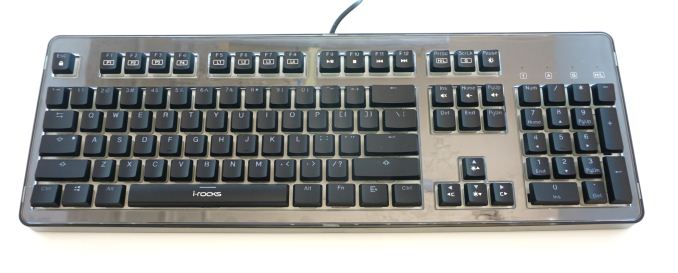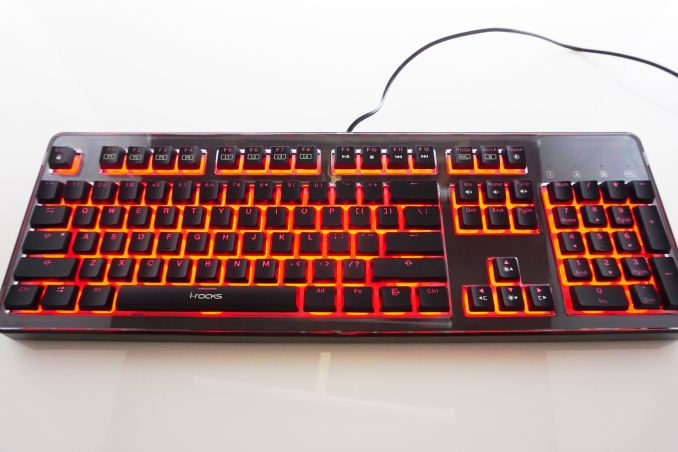The i-Rocks Pilot K70E Capacitive Gaming Keyboard Review: Our First Capacitive Keyboard
by E. Fylladitakis on September 21, 2018 8:30 AM EST- Posted in
- Peripherals
- Keyboard
- capacitive
- i-Rocks
Conclusion
Capacitive switch keyboards are very interesting to encounter, but the current number of products and manufacturers is very limited. Undoubtedly, advanced users would like to get their hands on a keyboard with Topre capacitive switches, yet the humongous cost of these switches priced every keyboard that tried to implement them right out of the market. What i-Rocks hopes to achieve with the Pilot K70E is to entice those same advanced users who are intrigued by the special properties of capacitive switches by leery of the price, offering them a product that would not cost significantly more than a top-tier mechanical keyboard.
i-Rocks engineers were clever about the design of their capacitive switches. Instead of making everything proprietary, they designed the stems to be compatible with keycaps from the vast majority of current mechanical keyboards. Single-cap replacements will be difficult due to the keyboard's low-profile stock keycaps, meaning that the user will probably have to replace all of the keycaps, but switching to custom keycap sets made for mechanical keyboards is possible. Using the membrane dampeners as lighting diffusers also works fantastically, creating perhaps the best lighting effect that we have seen to this date.
Aesthetically, the Pilot K70E initially feels a little bit kitschy due to its large size and the extensive use of acrylic. Once the keyboard is powered-on though, the acrylic diffuses the light coming from the LEDs perfectly, creating a fantastic visual effect. The ability to take off the keyboard's top cover and insert pictures/prints beneath it is a great customization option, allowing users to easily personalize their keyboards and without any lasting consequences.
Although it may not be really fair to compare a capacitive keyboard to a mechanical one, it is inevitable, as virtually all of the competition is mechanical keyboards. The truth here is that the Pilot K70E feels more like a membrane keyboard rather a mechanical one. Of course, it does not require the keys to bottom-out in order to actuate like a membrane keyboard does, but the feeling of each keypress is similar to that of mainstream membrane-based keyboards.
That is not necessarily a bad thing, as the silicon cones acts as dampeners, reducing the stress at the fingertips and greatly reducing the noise output of the keyboard. However, users who are used to the austere precision of mechanical switches, especially non-linear tactile models, are likely to find the Pilot K70E unsuitable for their needs. The capacitive switches also have other advantages, such as the ability to program the actuation/reset distances. The Pilot K70E does not take full advantage of this feature, offering the ability to switch between "low" and "high" actuation points for the entire keyboard, yet this could change with future firmware/software releases.
Where the Pilot K70E is mainly lacking is in terms of software and customizability. The software is just too rudimentary for a keyboard of this price range, greatly limiting the keyboard's value for advanced gamers. It does offer extensive lighting control options but few practical settings and very limited programmability. The lack of dedicated basic media/audio controls may also be a problem for some users who will not be fond of using keypress combinations just to turn the volume up or down.
The i-Rocks Pilot K70E is a valiant effort by the Taiwanese company to market a capacitive keyboard at a reasonable retail price. However, the cost remains relatively high and the Pilot K70E may be a bit too simple in order to compete with the top-tier mechanical keyboards it is being pitted against. Nevertheless, the Pilot K70E is a fine choice for users who want to possess a quality capacitive keyboard that will not cost them an arm and a leg.












27 Comments
View All Comments
vanilla_gorilla - Friday, September 21, 2018 - link
What do you mean a keyboard is "salty" ?wonderbread2 - Friday, September 21, 2018 - link
I am salty about his misappropriation of my (gamur) cultural slang.wonderbread2 - Friday, September 21, 2018 - link
(Nice review, always interested in topre like switches)Ryan Smith - Friday, September 21, 2018 - link
Unpleasant in large quantities.wrkingclass_hero - Friday, September 21, 2018 - link
During the course of testing it as his personal keyboard it was imbibed with a salty substance.DanNeely - Friday, September 21, 2018 - link
Actuation distance varying with humidity seems like a major issue outside of a climate controlled environment, especially combined with a non-tactile actuation you can never be sure where the actuation point is on any given day. While $150 is already a premium product, it really sounds like they need to add another dollar or two to the BOM to add a humidity sensor and use it to calibrate the sensor and stabilize the actuation point.bug77 - Friday, September 21, 2018 - link
That's true, but 70%+ humidity (like tested) is well into uncomfortable territory anyway.DanNeely - Friday, September 21, 2018 - link
Agreed, but E. Fylladitakis is far from the only person whose chooses to suffer in a steam bath instead of buying an AC. And presumably they'd have the opposite problem in the winter when many furnaces end up dedicating inside air to the point that static shocks become an issue.FunBunny2 - Friday, September 21, 2018 - link
"dedicating"or
desiccating
KAlmquist - Saturday, September 22, 2018 - link
Yes. I have air conditioning but don't keep the temperature and humidity the same all year round.